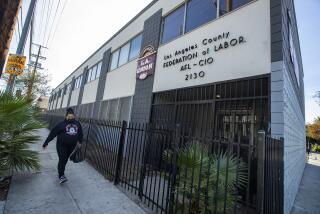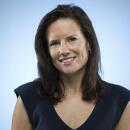Automatic ‘yes’ votes allow time for back-room dealing at City Hall
- Share via
Los Angeles City Council members have figured out how to be in two places at once.
It’s no magic trick. But some say the public is being fooled all the same.
Consider the council’s meeting on Nov. 25: On that day, Councilman Tony Cardenas voted to install a new executive at the Community Redevelopment Agency. He agreed to cut the budget by slashing overtime pay. He even voted to install a bronze bust of former Councilman Nate Holden at a municipal performing arts center.
Yet Cardenas was not in his chair for any of those votes. Instead, the San Fernando Valley councilman was behind closed doors in a nearby private room for an hour and 50 minutes. As he conferred with an aide to Mayor Antonio Villaraigosa, a computer at his desk in the council chamber automatically voted “yes” on those issues -- and eight others.
Cardenas is hardly alone. The city clerk’s office, which maintains the council’s official record, does not track how often members leave the council floor while still being counted as present. Times reporters monitored the back rooms repeatedly from August to February, however, and found that at least half of the council used them for private sessions during public meetings.
* On Nov. 24, the official record showed Councilwoman Janice Hahn casting a vote in favor of a new Villaraigosa appointee to deal with issues facing the city’s disabled residents. In fact, she was in a private room at the time with lobbyist Ben Reznik discussing Ponte Vista, a proposed housing development in San Pedro.
* On Jan. 8, the record had Councilman Richard Alarcon voting to seek hundreds of millions of dollars in federal stimulus funds for city initiatives. Instead, he was holding closed-door meetings across the corridor -- first with a deputy mayor, then with city lawyers.
* On Jan. 22, the record showed Councilman Herb Wesson voting to create a foreclosure prevention program. That occurred as he was smoking a cigarette in an outdoor courtyard that abuts the Spring Street steps of City Hall.
On several occasions, three or more council members disappeared from public view, holding staff meetings, giving interviews to reporters or taking cellphone calls. And at least twice, the council had three members conducting back-room meetings at the same time.
Many council votes are routine, and members could argue that time spent with lobbyists, mayoral aides or even reporters is more valuable than responding to repeated roll calls. But few make that case. A spotty voting record can easily become a political liability.
So instead of being recorded as absent, the council members have a technological fix: The chamber’s voting software is set to automatically register each of the 15 lawmakers as a “yes” unless members deliberately press a button to vote “no.”
The “yes” votes then flash on video screens throughout the chamber -- and are placed in the clerk’s official record -- even when members have left to grab a snack in the hall or hold a meeting.
Lawmakers in New York and San Francisco are also allowed to leave their seats during meetings, but members must be in the room to have their votes recorded. When Los Angeles County supervisors leave their meeting room, they are no longer allowed to vote.
On the City Council, by contrast, some members even schedule their time in advance to use the flexibility the voting system allows. Last year, for example, Alarcon made concurrent meetings so routine that he scheduled them on his official appointment calendar to coincide with the council’s regular 10 a.m. public sessions. The calendar showed he had appointments planned during 57 council meetings last year.
On Oct. 23, he scheduled meetings with lobbyists for 10:15 a.m., 10:45 a.m. and 11:15 a.m. -- all while the council was in session. The clerk recorded Alarcon as being present for every vote that day.
The rules of the council state that members must activate their own voting machines and must be within the council chamber to be counted as present. But the city attorney who advises the council said his office has defined the “chamber” to include the back rooms, bathrooms and news conference area, all of which are out of public view.
Deputy City Atty. Dion O’Connell said lawyers told the late John Ferraro, who was council president a decade ago, that members could go into the private rooms and still be considered present as long as they could hear the council proceedings on speakers set up in each area.
Five people who have gone into those rooms in recent months with the council members said they never heard the speakers turned on. One of them, Stuart Waldman, president of the Valley Industry and Commerce Assn., said he met with Alarcon in a room last August but heard nothing being piped over the so-called squawk box.
“There was no audio,” Waldman said.
Asked about their absences, several members said they leave the council floor only when they plan to vote “yes.” And they said they keep up with the meetings by listening to the audio feed. After council members received inquiries from The Times, squawk boxes could be heard more regularly in the rooms behind the council floor.
Still, their physical absence frequently infuriates members of the public who show up to testify only to find themselves addressing one or more empty chairs.
“We go there to talk to the full City Council,” said Ziggy Kruse of the Hollywood Studio District Neighborhood Council. “If you get eight people in their seats, you’re lucky.”
The practice shows a “profound lack of respect for the public,” said Terry Francke, general counsel for Californians Aware, a group devoted to preserving open government. “It seems to me to say, ‘My time is too important right now to spend it actually participating in a meeting where I was elected to represent the public.’ ”
In some cases, the practice also could raise questions about whether the council is in compliance with rules that require 10 members to be present to conduct business.
Councilman Tom LaBonge said members increasingly have been conducting lengthy meetings in the private rooms over the last few years. He added that he is “no saint” when it comes to staying in the chamber’s public area.
Cardenas defended the time he spends in the private areas, saying he is well-versed on items that receive his automatic approval: “If I’m not present in front of my desk, it doesn’t mean that I haven’t considered the item or that I’m not aware of it.”
During one meeting last month, Councilman Dennis Zine asked someone to retrieve Councilman Jose Huizar from a private room because he was scheduled to speak. Huizar called that unusual, saying he rarely leaves the council floor.
Huizar’s appointment calendar shows that he set up separate meetings with lobbyists, his staff and other officials during at least 45 of the council’s 132 meetings last year. Huizar said at least some of those meetings were canceled or held on the council floor.
City Council President Eric Garcetti said that many issues are worked out in advance in committee meetings and that accidental “yes” votes are rare. Garcetti said he has admonished several members over their disappearances, adding that they should step out only for “immediate needs, emergencies and in order to keep the chambers as quiet as possible.”
“That doesn’t mean stepping out for an hour,” he said.
More to Read
Sign up for Essential California
The most important California stories and recommendations in your inbox every morning.
You may occasionally receive promotional content from the Los Angeles Times.












